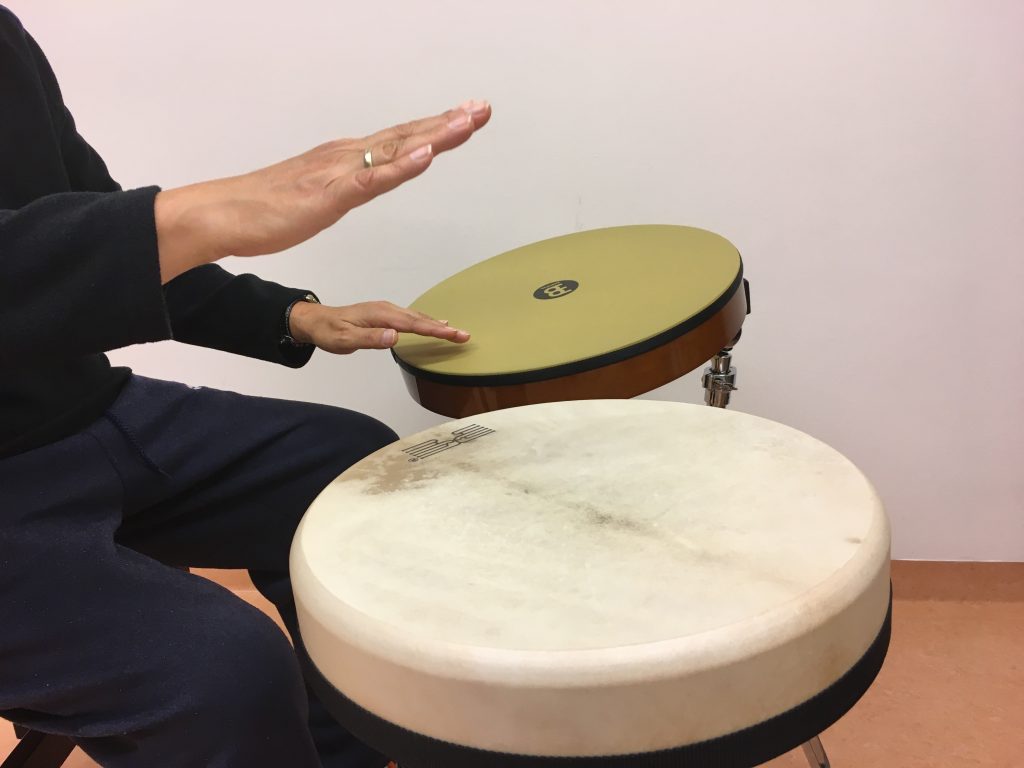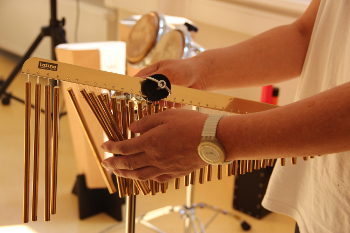Treatment techniques of neurological music therapy according to Thaut for cognitive training are described here.
The rehabilitation of cognitive functions can be sustainably improved through music therapy techniques. Cognitive performance is inherent in making music. This enables the development of specific musical exercises for perception, attention, memory and thinking.
Musical activation of alertness and awareness

Quantitative consciousness disorders are coma (not awakenable), Sopor (can be briefly awakened to pain stimulus), and Somnolence (can be awakened for a longer period of time upon contact). Awake people can be in one vegetative status (alertness without consciousness), in one minimally responsive status (Wakefulness with partial consciousness) or over complete awareness feature. Awake and conscious people can in one acute psychosyndrome suffer from severe neuropsychological disorders. These include extreme slowness, lack of attentional focus, fixation on individual environmental stimuli, disorientation, lack of day-to-day memory, lack of voluntary reactions, lack of awareness of illness (anosognosia), psychomotor restlessness, aggressiveness, or apathy. For these severely affected patients, Musical Sensory Orientation Training (MSOT™) offers an initial therapeutic approach.
It contains two parts:
(1) Goals of early musical stimulation are the initiation of wakefulness, awareness, basic orientation to body, space and time as well as initial reactions appropriate to the situation.
(2) Building on that with simple active musical exercises Continued attention is encouraged, regardless of the correctness of the reactions.
Musical perception training
In contrast to the visual system, there are hardly any neuropsychological exercise methods for the hearing system, despite the high importance in everyday life. With musical exercises, neurological disorders of auditory perception can be treated well.
The auditory perception training- Auditory perception training (APT™) comprises two parts:

(1) In auditory perception training the distinction between different sound components is practiced, e.g. pitch, duration, tempo and rhythm.
(2) At the sensory integration different sensory modalities are combined: listening to music with sensation (e.g. vibration), with movement (e.g. weighing) and with seeing (setting images, e.g. clouds).
Musical neglect training
With a neglect, perception and attention to the area of the body and body opposite the brain damage are impaired. A neglect is usually multimodal, ie the patients neglect visual, acoustic and tactile stimuli on the affected side and / or move the limbs on this side too little. Seeing, hearing, sensitivity and movement are basically preserved. A further complication for the therapy is that the patient is not aware of the disorder (anosognosia).
In Musical Neglect Training (MNT™), patients involuntarily direct their vision, hearing, movement, and attention toward the neglected side while actively playing an instrument. Musical structures and the spatial arrangement of the instruments toward the neglected side are excellent tools for this.
Musical attention training
Neurological disturbances in attention lead to a reduction in general responsiveness, slowing down, incorrect working methods, impaired attention sharing, distractibility and reduced permanent attention.

As part of the musical attention training - Musical attention control training (MACT™) specific music interventions were developed to promote the various attention components:
(1) Sustained attention is built through general reactions to changing musical stimuli.
(2) Selective attention is promoted by directing attention to a specific musical stimulus, by carrying out a targeted reaction to this stimulus and by masking out other musical disturbance stimuli.
(3) Alternating attention is promoted by alternating attention between two or more stimuli.
(4) Divided attention is trained by the simultaneous attention to several musical stimuli and the implementation of certain reactions to each of these stimuli.
Musical memory training
As a complex system, memory comprises many different sub-components. Memory disorders can affect linguistic content (e.g. texts) and / or pictorial spatial material (e.g. faces, paths). Neutral information (e.g. news) or personal experiences (e.g. vacation), short or long-term information (minutes to years) as well as conscious content (e.g. conversation information) or unconscious routines (e.g. movement sequences) can be disturbed. When learning, the repeated impressing of new information (e.g. vocabulary) and the so-called prospective memory (memory for the future) can impair the memory for appointments and agreements.
In Musical Mnemonic Training (MMT™), musical stimuli (songs, easily remembered melodies) serve as memory templates into which non-musical memory information (e.g., names, orientation information) is integrated. Remembering the musical structure facilitates the retrieval of the non-musical memory information.
A variant is the mood-dependent memory training- Associative Mood and Memory Training (AMMT™), in which memory information is linked to a mood induced by music, thus linking the learned information to mood nodes.
Musical planning training

Executive functions encompass the planning, execution, control, and evaluation of actions on a practical, linguistic, and intellectual level. The highest level of human brain function in this area is the ability to abstract. This enables the person to transcend concrete things by forming mental concepts. Accordingly, executive dysfunctions include a lack of abstract ability and reduced flexibility, poor decision-making skills, impaired implementation of plans into actions, hasty use of non-goal-directed actions, rule violations, poor error control and learning from mistakes, giving up quickly, justifying problems, and a lack of awareness of the disorder. In Musical Executive Function Training (MEFT™), all of these components can be trained with musical exercises in a group or individually. Group therapy is particularly suitable for practicing goal-directed dialogue and collaboration.